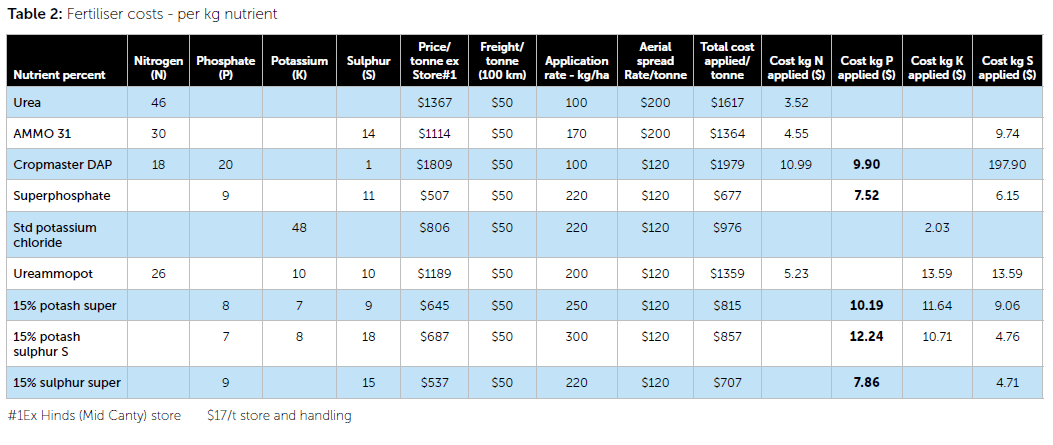Bang for your fert buck
Soaring fertiliser costs in the wake of international events is under focus for hill country farmers, Tom Ward writes.

Soaring fertiliser costs in the wake of international events is under focus for hill country farmers, Tom Ward writes.
With substantial increases in fertiliser prices a certainty, particularly but not exclusively, nitrogen products, the focus needs to move on to how to best use the fertiliser spend.
The 2020-21 Beef + Lamb NZ forecast expenditure on seeds was a decline by 7.6%. Lime and fertiliser accounted for 17% of farm working expenditure. For 2021-22 (March to March), fuel prices increased 54%, and fertiliser, lime and seeds prices increased 23%.
Although hill country incomes are at very good levels, it is sobering to see the relatively small increase in profit.
B+LNZ have reported a weighted average farm profit before tax, for all classes, shown in Table 1.

The NZ/USD exchange rate from March 2021 to March 2022 moved from 71 cents down to 68c, reflecting an average US/NZ exchange rate of 69%. Fertiliser applications have been 26 to 28kg/ha in recent years.
Between mid-2020 and May 2022 nitrogen, phosphate, potassium and sulphate fertiliser prices increased 140%, 19%, 41% and 20% respectively. Since then these fertilisers have increased respectively, 3%, 33%, 34% and 38% driven by international shortages out of Russia and China. In addition, the exchange rate, driven by the US central bank lifting interest rates, has declined to 63c, which will be good for the sector if that can be maintained.
The high cost of nitrogen suggests a greater focus on P, K and S, in order to generate more nitrogen from legumes, would be desirable. It might also be possible to reduce some NPK inputs.
Where the Olsen P level is high, phosphate fertiliser can be withheld or reduced for a few years without any negative effect on productivity. This is because the pool of available phosphate could be 10 times the amount needed to be available to the plant in any one year. Care needs to be taken that the “pool” of P is not significantly depleted leading to an expensive recovery process. Keep an eye on the most limiting nutrient.
The situation with sulphur (S) is different to phosphorus (P), and a sulphur deficiency can develop very quickly (within 12 months). Sulphur becomes available from the soil organic matter in roughly the same proportions that is required by the plants. However, it leaches easily in a high rainfall climate (e.g. South Island West Coast) and in a very dry climate, like the Mackenzie country, sufficient S will never become available from natural processes. So S nutrients need to be constantly added. Furthermore, the soil test for available S is very unreliable.
In the early spring, clovers will benefit from additional elemental sulphur, rather than nitrogen, as low temperatures can limit the release of soil sulphur.
Potassium (K) is different again with a relatively large proportion of the element present in the animal/plant cycle so potentially liable to be removed each year. There is disagreement among soil scientists as to whether this element is in general decline in NZ soils. Optimum K levels are 7-10.
Remembering that nitrogen is the most limiting element, there is no reliable test for available nitrogen in NZ soils, although we can estimate it and look for signs in the plants. Adequate N in the clovers is 4-5% and optimum legume content in pastures 30-40%.
Table 2 highlights some interesting issues.

First, urea is still the cheapest form of nitrogen (N), although not by much, especially when the value of sulphur (S) in AMMO 31 and the value of nitrogen in DAP is accounted for.
Secondly, applying maintenance fertiliser at 20kg/ha P, 10kg/ha K, 20kg/ha S) there are two lessons.
First, 250kg/ha 15% pot super (P-K-S: 20-17.5-22.5) will cost $204/ha, whereas 250kg/ha 15% straight super with 20kg/ha potassium chloride (0-0-48-0) added (blend 22.5-10-27.5), will cost $189/ha, a 8% saving.
Another way to “skin the cat” is to apply 100kg/ha DAP (18-20-0-0) with 20kg/ha KCL (0-0-48-0) and 100kg/ha sulphur super 20 (0-8-0-20). This gives a 18-28-48-20/t blend, or 18-20-10-20/hectare. The applied cost is $288/ha, which is $10.28/kg P. However, if you apply the $189/ha in the super/KCL example in the paragraph above as the opportunity cost, the N cost is $5.50/kg.
Second, assuming a hill country pasture grows eight tonnes of drymatter/ha per year; with 75% grass, a nitrogen input of 250-300kg/ha would be required to grow this pasture. Applied as urea at $3.52c/kg N, the cost would be $1056/ha/year (300kg N/ha, 13.2c/kg DM), compared to the $190 to $205/ha/year to maintain a grass/clover pasture (2.5c/kg DM). In addition the pasture quality, as a livestock feed, will be higher due to the clover.
Prioritising expenditure away from fertiliser to increasing lime, which has only increased by the cost of application and freight, could be considered, especially if the farm is marginal in some areas for pH. Quantifying the immediate benefits of lime is difficult, however, there are long term improvements to soil organic matter.
To optimise the use of the fertiliser spend the farmer could consider prioritising different land classes with the most fertiliser going on to the most responsive soils. Either the best soils, higher rainfall areas, or the summer country in high rainfall areas, or shady country in dryer climates. Being very clear about environmental regulations is also a help here. Well subdivided paddocks utilise feed better.
In summary, farmers are having to react to rising costs with fertiliser being one of the biggest. Keep an eye on the most limiting NPK nutrient. Cashflow for hill country farmers is good at the moment. If farmers are having difficulty achieving their fertiliser goals, they may have a balance sheet issue.




